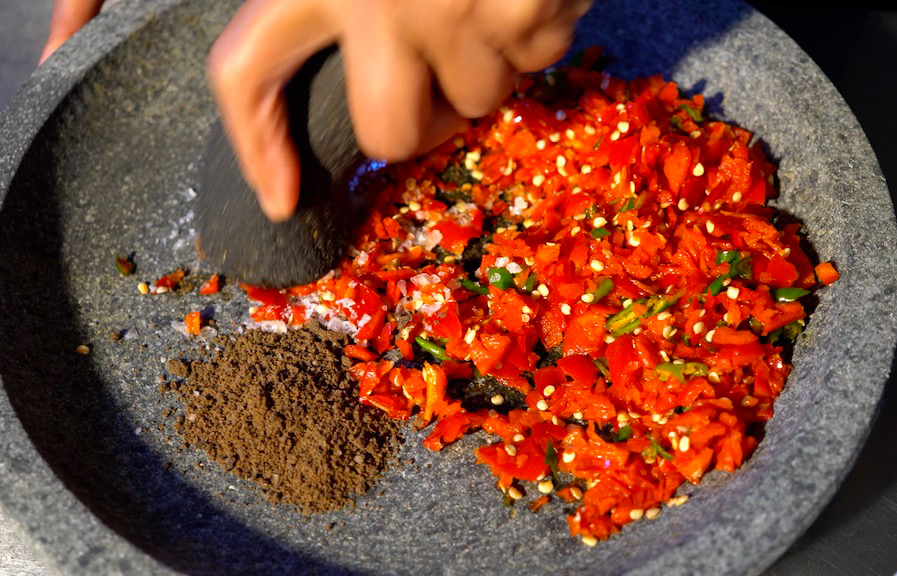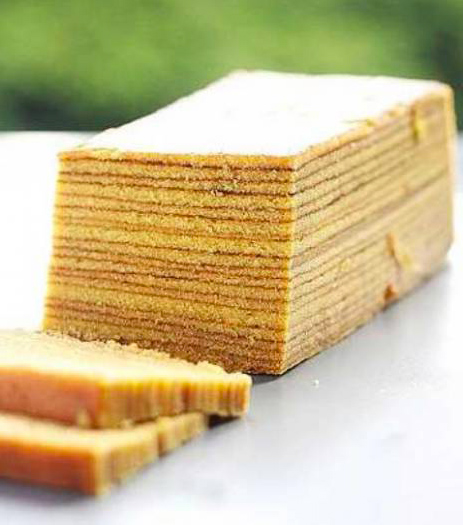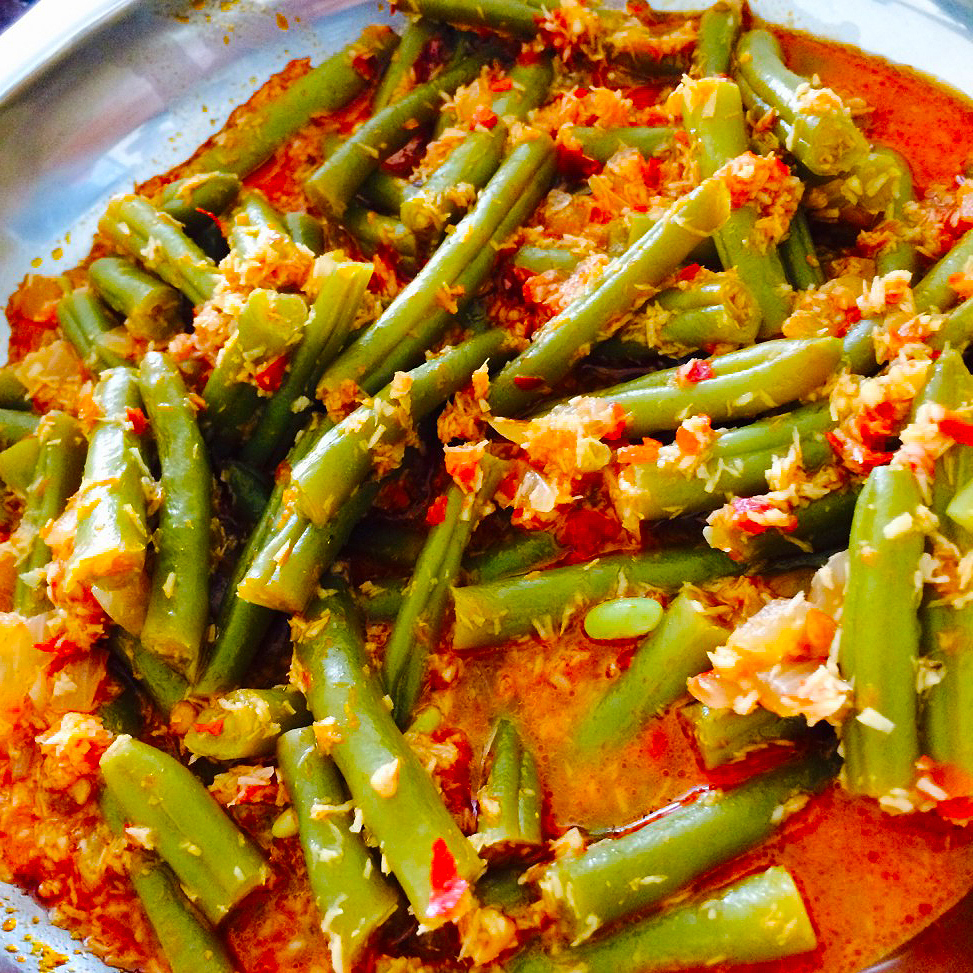I grew up with the flavours of Indonesia…
I grew up with the fragrances of Indonesia – of toasting coconut and mixed spices, of rice steaming in cone-shaped bamboo baskets, of fragrant sambals and the waxy smell of hand-painted batiks that the women wore to the selamatans – those social gatherings that celebrated anything from a pregnancy or birth or a new job to the successful completion of studies…
I would do my school homework in the kitchen, whilst my mother made spekkoek – an ultra-rich, laboriously layered cake of dozens and dozens of wafer-thin buttery pancakes flavoured with cinnamon, cloves, cardamom, nutmeg and mace – so rich that we could only ever manage one very thin slice!
Other days the kitchen would smell of boiling vinegar, turmeric and chillies when a batch of atjar tjampur — a fragrant, mixed vegetable pickle — was in the making. My mother might make our favourite serundeng— a side-dish made with slowly toasted coconut and peanuts, perfumed with cumin and coriander. Or rempeyek— a crunchy savoury peanut brittle. Abon abon too — another condiment, made from slowly dried and sweetened, shredded meat (or its shellfish equivalent ebbie ebbie). We called it monkey hair because of its texture.
My dad cooked too and had his own specialities. He was always in charge of frying the krupuk (huge, flat sheets of prawn crackers) and emping, and of course the regular family besengek or saté padang barbecues on Sundays.
Yet, despite this total immersion in Indonesian culture, I grew up in Holland. My father had left Java in the fifties and, unable to suppress his love for all things Indonesian, started a business importing food and cooking equipment from there. Around the same time many Indonesians also emigrated to Holland – where they integrated with ease into Dutch Society. Inter-racial marriages were both common and celebrated and Indonesian food was adopted with gusto – not only in the homes of Dutch families but in the many restaurants that still offer elaborate rijsttafel dishes on their menues.
Rijsttafel (meaning rice-table in Dutch) is the result of a collective ‘collaboration’ between Indonesian and Dutch culinary traditions dating back to the Dutch Colonial Era – evolving as a way for Dutch citizens living in Indonesia to impress their visitors and show off the colony’s enormous wealth of exotic abundance…
At home an Indonesian meal can be as simple as a single-pot dish such as nasi goreng (fried rice with onions, ginger, cumin and meat and lots of ketjap) or bahmi goreng (a stir-fried noodle dish with meat, celery, leeks and cabbage). A rijsttafel on the other hand is a huge celebratory affair served on special occasions – usually a central dish of plainly boiled rice with anything between five and fifteen separate dishes of spicy fish, vegetables, chicken, beef, pork and eggs, each in its own uniquely flavoured sauce, and always accompanied by umpteen side dishes of handmade condiments – crispy, crunchy, hot, sour or salty…
Many of my parents’ friends were Indonesian. They taught us so many things. Among them was an old lady we called Oma (Dutch for granny) Hamar. She descended from an ancient bloodline of Indonesian nobility but she knew how to cook and spent much time with my parents, talking and teaching them about Indonesian culture and food and traditions.
She and my mum wrote these recipes down and the little book in their neat, beautiful handwriting is now in my possession. I treasure it and I still make the recipes below. They take time, but it is a therapeutic way to deal with today’s hectic lifestyles. And today, another generation on, my children count these dishes among their all-time favourites….
SEROENDENG
A dry, more-ish condiment traditionally served on the side or sprinkled over all sorts of Indonesian dishes for texture – it would be equally delicious with Thai food. This recipe makes quite a quantity but, stored in an airtight, paper-lined tin, it keeps for ages.
2 tbsp vegetable oil
2 cloves of garlic, crushed
3 tbsp ground laos (galangal)
1 tbsp ground ketumbar (coriander)
1 tbsp ground djintan (cumin)
400 g desiccated coconut
300 g roasted peanuts
Heat the oil in a large frying pan and gently fry the spices over low heat. Stir in the desiccated coconut and mix thoroughly. Stirring all the time, gently toast the coconut for 10 minutes, until a light golden.
Put the pan on a heat diffuser and turn the heat down to its very lowest. Now very gently and stirring regularly to prevent burning, dry the coconut for about 1 hour.
When completely dry, stir in the toasted peanuts and continue cooking for another 5 or 10 minutes then store in an airtight tin for up to 3 months.
ABON ABON
A soft textured side dish of dried, slightly sweet meat, which is sprinkled over Indonesian food. Also great as a nibble with pre-dinner drinks. This can be stored, in a paper-lined, airtight tin, for 2 months.
500g lean stewing beef in one flat piece
1 small piece (25 g) asam (tamarind pulp)
4 tbsp water
4 tbsp vegetable oil
1 medium onion, finely chopped
3 cloves of garlic, frushed
1 small red chilli, finely chopped
4 tbsp ground laos (galangal)
2 tbsp gula djawa (jaggery or dark brown sugar)
½ tsp salt
In a saucepan, cover the meat with water. Bring to the boil and simmer until completely tender (about 30-45 minutes).
Meanwhile, put the tamarind and warm water in a small bowl, then press and squeeze with a spoon until the water becomes thick and brown. Strain through a sieve, discard the tamarind pulp and seeds, and set the liquid aside.
Remove from the meat from the water and allow to cool. Using two forks, pull the meat into tiny threads.
In a large frying pan, heat the oil and gently fry the onion, garlic, chilli and galangal. Add the sugar, salt and tamarind water as well as the threaded meat and mix well. Over medium to low heat, stir-fry the mixture for 10 minutes.
Put the pan on a heat diffuser and turn the heat down to its very lowest. Very slowly dry the meat for up to 2 hours, tossing regularly to prevent burning.
The meat will become crispy and when it is completely dry, store in a paper-lined, airtight tin.
SAJOUR TOUMIS BOONTJES
This dish is ideal for reinterpretation – I’ve used a combination of chicken stock and dried prawns (available from Asian food stores) and garnished it with hard-boiled eggs. But you can also use minced pork instead of prawns, leave out the eggs and add or omit vegetables of your choice. Serve with plainly boiled rice and the condiments below, on the side.
3 tbsp of vegetable oil
1 medium onion, finely chopped
1 small red chilli, finely chopped
200 g dried shrimps or prawns
3 tbsp ground laos (galangal)
2 tbsp ground ketumbar (coriander)
1 tbsp gula djawa (jaggery or brown sugar)
800 ml of good, home-made chicken stock
600 g French beans, cut into 3cm lengths
½ cucumber, cut into small sticks
300 g fresh bean sprouts
4 hard-boiled eggs, peeled and halved
In a saucepan heat the oil and gently fry the chopped onion until transparent. Add the chilli and dried prawns and continue frying for another 8 minutes or so. Add the spices and fry for another 2 minutes. Next stir in the sugar and stock and bring to the boil. Add the French beans, simmer for 5-8 minutes or until almost cooked then add the cucumber and bean sprouts and continue cooking for another 1-2 minutes.
Float the halved eggs, yolk-side up, on top and serve hot, with plainly boiled rice and some abon abon or serundeng on the side.



